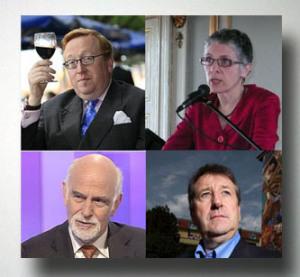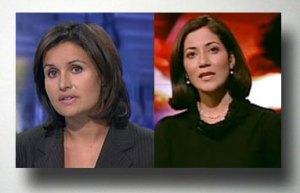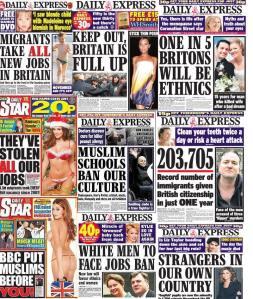 Back in 2009 I wrote an article in The Guardian on the ‘Media’s all-white club’. This was prompted by my research into the racial diversity of BBC Radio 4 presenters. Out of 100-plus regular presenters just two were Asian and none from an African or Caribbean background.
Back in 2009 I wrote an article in The Guardian on the ‘Media’s all-white club’. This was prompted by my research into the racial diversity of BBC Radio 4 presenters. Out of 100-plus regular presenters just two were Asian and none from an African or Caribbean background.
This, despite the fact that Rajar figures showed a greater proportion of BAME communities listened to Radio 4 compared to the national population. So this notion of a white middle-class listenership wasn’t entirely true.
In reality the listenership wasn’t being reflected in the studio. And it was even worse behind the scenes. The backroom staff – the producers and assistant producers – were almost exclusively white. Trevor Phillips coined the phrase ‘snowy peaks’ to describe the upper echelons of business, but Radio 4 also had snowy valleys as well.
The then station controller, Mark Damazer, did produce figures for Black and Asian people working at the station. The trouble was when I looked at these more closely they were mostly freelancers. All of them! They came in, made a contribution and left again. Meanwhile the staff jobs – and staff salaries – went to white staff.
Why was this happening and how typical is this of the British media today?
The issue is of crucial important because media output reflects society back on itself. And international reports, with all the nuances and cultural attitudes underpinning the journalists’ dispatch, go a long way to shaping the worldviews of the British public.

Typical coverage of the 2011 London riots
Take the London riots of 2011. “Moron” is one of the kinder words tabloids such as The Sun used. On the inside pages words such as “cockroach” and “rat” were used to describe the rioters. Dehumanising words.
I’m not defending what happened that week at all. Criminality must be punished. Yet the newspapers in particular went a long way to setting the public mood which, in turn, allowed politicians to pressure the judiciary to make an example of those caught. So rioters got unusually heavy prison sentences for stealing water, chewing gum and ice-cream.
The riots panel – set up by Nick Clegg, the deputy prime minister – didn’t have a lot to say about the media but did acknowledge the perceptions about media coverage expressed by the young people they spoke to.
The report noted:
“We heard from many about the negative images of young people portrayed by the media, which help to fuel a negative stereotype of young people. This then shapes society’s views of the value young people can add and impacts on employers, local residents and young people themselves. Only 14 per cent of people in the Panel’s Neighbourhood Survey feel that the media is positive about young people. This feeling was also widespread among the young people we spoke to.”
Of course the London riots weren’t a ‘race riot’ – young people of all backgrounds took part. But there were many who recognised the similarity between coverage of the disturbances in 2011 with coverage of the Brixton riots in the early 1980’s.
Added to this were the issues not adequately explored in the tabloids such as the perception that the shooting of Mark Duggan was an example of oppressive policing. Issues of high youth unemployment in the inner cities, social exclusion and the impact of government austerity cuts on local youth services.
These are issues that disproportionately affect Black youth. So race did play its’ part, if not in the disturbances themselves then certainly it was implicit in the media coverage.
Did the racial composition of the media affect the way this event was covered? It’s hard to say for sure. The age and social background or ‘class’ of the journalists and editorial decision-makers may have been a factor too. But the question is: does a critical mass of Black and Asian journalists make a difference to the nature of the output?
To draw a parallel with the police, the diversity debate – from the Lord Scarman report to the Sir William Macpherson report into the death of Stephen Lawrence – has centred around changing the ‘canteen culture’ by hiring more officers who are able to challenge attitudes. The argument goes the more Black and Asian officers there are the more comfortable they will feel about challenging policies and practices.
Whether we are talking about dealing with ‘a few bad apples’ or institutional racism the principle is the same… diversity is not just about the color of the workforce, it’s about how the organisation works.
Individually, police officers may not be able to affect much change on the newsroom floor, but if there are enough right-minded people then more progress can be made about how stories are treated.
This is important because the media there to serve everyone and if it is not sufficiently sensitive to the perceptions of sections of society and is not reflecting and representing them properly then there is an issue.
The second reason why diversity matters in the media is the importance of visible representation. This is particularly important for TV, but we must not under-estimate the value of picture-bylines in the printed press or voices on radio.
When I was growing up in the 1970s there was excitement whenever anyone who was Black appeared on our TV screens. It was “Come, quick, there’s a black person on TV!” Of course times have changed… we’re much more used to seeing Black and Asian TV news-anchors, reporters and other presenting roles.
Some say that racial diversity at this level is often more diverse than society as a whole. And if that’s the case, it is justified in my view because it helps make-up for all those years when Britain’s multicultural society simply wasn’t represented on screen.
Yet leaving aside news anchors, generally speaking Black and Asian people on TV tend to be frequently posted on cover an ‘ethnic story’, or hold specialist posts like arts, entertainment and sport. Aside from Faisal Islam at Channel 4, how many economics reporters of color are there? And political reporters? There’s Rita Chakrabarti and John Pienaar for the BBC, but that’s about it. There is still pigeon-holing and stereotyping at play based on the perceived interests and talents of the BAME communities.

Model presenters: Nina Hossein and Mishal Husein
And all too often those that make it to become news anchors are highly likely to be people of color who were born with more European facial features. It’s a fact that appearances matter on TV yet it is worth asking whether the fact that there are a number of conventionally beautiful Asian women presenters and news-anchors has anything to do with their features being more ‘acceptable’ to a white audience?
I’ve nothing against Nina Hossein or Mishal Husein (pictured), but how often do we see a Sikh male presenter? Or a presenter with strong Nubian West African features? Or how often do we see a Black woman with natural hair? The fact is, the full range of facial features and shapes in our multicultural society are not reflected on our TV.
The issue here is one of conformity as well as physical acceptability. There is also a premium on dress; conforming rather than embracing diversity of expression. In other words, diversity on screen (such as it is) has yet to get much more diverse than skin color.
Perhaps more importantly the extent to which the mainstream media reflects society matters because the media affects public discourse on issues of race, culture, religion and identity.
Historically our parents and grandparents were reflected badly in the British media. The butt of jokes and stereotyping – from the Black and White Minstrels to Love Thy Neighbour to Jim Davidson’s ‘Chalky’ – the representation was crude and created exclusively through the eyes and minds of white people. Positive and multi-dimensional characters were few and far between. As a result, the media collectively created a distorted public perception of immigrant communities.
A lot has changed since then. When Professor David Starkey made his comments on Newsnight that “white youth had become black” there were hundreds of complaints. And recently when I launched an online petition to keep Mary Seacole on the national curriculum 36,000 people signed – many of them almost certainly white.
Yet aside from the question of how ‘anti-racist’ Britain has become in its’ social attitudes a cursory look at the statistics of deprivation and disadvantage and its’ clear that we still are a racially-divided society.
Whether we are talking about Black youth up to 28 times more likely to be stopped and searched, or Black men being twice as likely to be unemployed as their white counterparts or the gap in good GCSE results and disproportionate rates of school exclusion, the evidence of unequal racial outcomes is stark and has changed very little of the years. In many areas progress is actually going backwards.
Can we lay the blame for this at the media’s door? To assign all the blame would be grossly unfair. But there is an argument that the news media in particular are not doing much to challenge these issues. And I would argue this is directly related to the lack of Black and Asian journalists in a position to influence the agenda.
Considering how much of a scandal it is that rates of homelessness or mental health are disproportionately affecting BAME communities, there is a surprising reluctance to tackle these issues in the mainstream media.
Or at least the British media. Russia Today, al Jazeera and Press TV have all devoted greater attention to these structural issues of racial injustice, and have amassed a decent following among Britain’s BAME communities who turn to them for ‘the truth’ rather than Sky or the BBC.
Why should the mainstream media ignore such burning issues? Part of the blame can be attributed to the basic journalistic training and instincts to go for ‘breaking news’, but I don’t think that explains it by any extent.
Much of the problem is due, in my view, to the same reactions and emotions that many other institutions face when it comes to ‘race’. They are simply not comfortable ‘going there’. They would rather convince themselves that they are treating everyone equally than analyze themselves and be open to identifying discriminatory attitudes and institutional racism.
The absence of any willingness to apply the journalistic principles of exposing the truth to the scandal of unequal racial outcomes in Britain has created a vacuum that has been filled instead by Right-leaning commentators and columnists with an agenda in fostering a public discourse on race that is quite negative.
Columnists like Simon Heffer, Melanie Phillips, Trevor Kavanagh and Richard Littlejohn can be relied upon to churn out a regular stream of copy that demonises asylum seekers and immigrants, and frequently religion and culture too. And not all such columns refer to communities color the ‘problematisation’ of non-English people helps to foster public attitudes that impact particularly on people of color no matter whether they are second, third or fourth generation.
Of course there are more progressive columnists. Yet with the exception of Yasmin Alibhai Brown in the Independent there are no regular columnists of colour, and none that write about issues of race and inequality with any regularity. As much as Polly Toynbee is a doyen of the Left, she has little positive to say on these issues.
That’s not to say that Black and Asian journalists are there to write constantly about the condition of their own communities, any more than Black and Asian politicians are there to only represent their own. However if there were more BAME journalists and columnists gainfully employed in the mainstream then these subjects would get certainly more airtime and column inches. And that would be for everyone’s benefit because no one should want to live in a racially unequal society where prejudice holds back talent.

Daily Diet of negative images
When we are subjected to negative front-pages from the likes of the Daily Express and Daily Mail on a regular basis it alters the public discourse on race, disregards the positive enriching of Britain by the many nations and cultures in our multicultural society. Instead it breeds suspicion and division, inflates feelings of competition with other races for housing, jobs and health services, and allows politicians to keep ‘race’ off the political agenda.
That may not be the intention but its’ certainly the effect. Just as the self-replicating tendency when it comes to hiring journalists may not intend to exclude Black and Asian journalists, but the figures show that this is the outcome.
Having a more diverse media simply makes good business sense. It’s not about being “politically-correct”, as much as I loathe that word! It is simply that media organisations which overlook capable and talented Black and Asian journalists and the cultural knowledge they bring, miss out on a whole range of good stories as well as star journalists. They also miss the positive and inclusive image that advertisers want to see.
Pandering to prejudice is pandering to a declining audience as Britain becomes ever more diverse, as we saw from the recent population census figures. If media organisations want to survive and grow in a tough environment they need to raise their game on diversity. Editors know this. So why is progress so slow?
Back in 2001 Greg Dyke, then director-general of the BBC, famously he branded the Beeb as “hideously white”. In actual fact the BBC employs roughly the same proportion of BAME people as the population as a whole. Where it is lacking is senior management positions. The higher up you go, the whiter it becomes. And there are whole pockets of the Beeb where non-white faces are extremely rare. Radio 3 and to a large extent 4. The Nature programmes office in Bristol.
Sure, you’ll find Black and Asian people at 5Live, and certainly on 1Xtra! So are we not interested in classical music or nature? I know a lot of Black people who are.
In 2008 Trevor Phillips published a report entitled ‘Superdiversity Television’s newest reality.’ It noted:
“The media industry as a whole remains at some remove from the general population in its ethnic and faith make-up. The picture in front of the camera has improved; but behind the mike and in the executive layers of the industry little has changed from twenty-five years ago.”
The report proposed that:
“All major media players, including the top 20 independent production companies should agree to a voluntary code of monitoring of diversity of senior decision-makers in the industry, with results to be published annually.”
So far that recommendation has been completely ignored. So the whole issue of diversity in commissioning remains unresolved.
The situation is a lot worse in the commercial sector. Channel 4, for example, commission most of their programmes from independents. And they are probably the most undiverse part of the mainstream media today. But you’ll never know because they are not housed in one huge office but are spread out in their own small offices across London. If they need a studio they’ll hire one but if not the headquarters will hardly know they exist.
These independent companies do their own hiring, and as you’re guessing, they self-replicate. Too often its’ about who you know or the dinner party circuit. And if they don’t know that many Black or Asian journalists and don’t invite many to their dinner parties then the outcome is inevitable.
I’m sure many heads of independent film companies would say they want a diverse workforce, but simply haven’t taken the steps to bring that about.
A the same time as Greg Dyke’s comments, the European Monitoring Centre on Racism and Xenophobia brought out an interesting report into called ‘Racism and Cultural Diversity in the Mass Media‘. It noted:
“As yet there have been virtually no initiatives to recruit journalists from ethnic minorities. In 1995, out of approximately 5,000 staff journalists on national newspapers, fewer than thirty came from minority backgrounds, and there were no ‘black’ or ‘Asian’ editors, regular critics, or columnists. Since then, there have been a few limited changes, with the Financial Times, Telegraph, Daily Mail and the Guardian / Observer now having a number of ‘black’ and ‘Asian’ staff. This can in part be accounted for by the fact that recruitment of journalists for national newspapers tends to be done on an informal basis, rather then through formal advertisements and interviews, which makes journalism somewhat of an insider clique that is difficult to penetrate.”
The reference to print journalism being an “insider clique” is largely as true today as it was then. The report pointed to the informal recruitment practised of the mainstream print press as being largely responsible for the lack of diversity in newspaper newsrooms. It acknowledged that a small amount of progress had been made – and more progress has been made since that report was written. But it is still far too slow. And the observation that the print media had not put in place any specific initiatives is as true today as it was then.
While the broadcast union BECTU has done tremendous work with their Move On Up initiative to improve diversity in TV and radio, so far print hasn’t followed. The Guardian have a particular scheme, but nothing industry-wide.
So what are the solutions? Firstly, the newspaper industry should recruit in the same way as most other parts of the economy, with open advertisements and a transparent procedure. Out of the few Black and Asian journalists on mainstream papers a ‘gems’ have been uncovered almost by accident.
Afua Hirsh, the Guardian’s legal correspondent, had little experience of journalism – just writing for Young Voices, the Voice’s youth supplement. She worked a solicitor but fancied a change of career. She contacted the paper and the rest is history. And Gary Younge – who is one of my heroes – only ended up at the Guardian because he got on a diversity internship. So how many more excellent journalists from BAME backgrounds are there?
The answer is a lot. But the opportunities for entry are minimal. If the recruitment procedure was open and clear they would expose themselves to a great deal more talent and that can only be to the benefit of the newspapers themselves.
Secondly, we need to focus extensively on regional and local papers. For many they are the training grounds, the gateways, which allow entry to Fleet Street. Yet many of them, especially the ‘big city regionals’ are heavily white. While they remain inaccessible the flow of BAME journalists to the nationals will remain at a tiny trickle.
Thirdly, Black and Asian journalists in the media need the networks of support that some of their well-connected white already benefit from. Not just for their professional development but also so that they do not feel isolated and feel confident enough to challenge assumptions in the media as well as confront bad behavior.
The report ‘Why ethnic minority workers leave london’s print journalism sector’ said:
“Ethnic minority journalists reported that they had often felt reluctant to challenge racist behavior when working in the sector for fear of being labelled as, or singled out as, ‘troublemakers’, or even losing their jobs. Some ethnic minority ex-journalists felt that challenging editors or colleagues about racism would lead to them being ‘blacklisted’ in the industry, and thus make it impossible to find work on other titles or to further their careers.”
Clearly this needs to change. Opening up the media – print, broadcast and the independent sector – to diversity requires action. And that means structural changes to ensure fair and transparent recruitment, reflecting society in its’ fullness and allowing diversity of expression, and challenging their own institutional attitudes and ways of working that are all too often out of step with a modern multicultural society.
And hopefully that will bear fruit in the way the media also report on the issues with less stereotyping and scaremongering, and more attention to the scandals of unequal outcomes and discrimination that are clearly ‘news’ but seldom reported.
By Lester Holloway @brolezholloway
